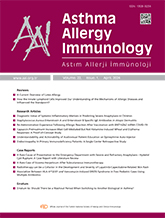


Objective: Inborn errors of immunity (IEI) are a diverse group of inherited diseases that affect the innate and adaptive immune systems, leading to symptoms and signs related to infections, autoimmunity, and allergies. There is a remarkable correlation between IEI and endocrinopathies. Our study aimed to retrospectively analyze the clinical, immunological, and endocrine features of our IEI patient group.
Materials and Methods: We retrospectively reviewed medical records of IEI patients from our clinic.
Results: Our study included 40 patients (23 men, 17 women) with a median age of 37 years (range:24-66). The predominant clinical phenotype observed was primary antibody deficiencies (92.5%). Only two patients had a genetic diagnosis: one with a pathogenic variant in the nuclear factor-kappaB2 deficiency (NFKB2) and another in Wiskott-Aldrich Syndrome (WAS) genes. At diagnosis, only one patient had endocrinopathies, but during the last visit 13 patients (32.5%) developed at least one endocrine pathology, among which thyroid disease was the most common. Thyroid disease was present in 11 patients (four with thyroid nodules, three with primary hypothyroidism, two with primary hypothyroidism and thyroid nodules, one with secondary hypothyroidism, one with Graves` disease). Additionally, adrenal insufficiency was observed in five patients and primary hypoparathyroidism was found in one patient. The patient diagnosed with NFKB2 deficiency was investigated for potential endocrine disorders that could accompany the genetic defect, despite the absence of clinical symptoms. The patient was subsequently diagnosed with central adrenal insufficiency following these investigations. Another patient in our study had primary adrenal insufficiency, primary hypoparathyroidism, thyroid nodule, and chronic mucocutaneous candidiasis. No mutations in the autoimmune regulatory and forkhead box protein P3 genes were detected in the targeted genome sequencing. Further genetic examination was planned for this patient.
Conclusion: In our study, endocrinopathy was a frequent comorbidity observed in our IEI patients. We believe that establishing appropriate screening programs for endocrinopathies in IEI patients is crucial to guiding healthcare professionals.